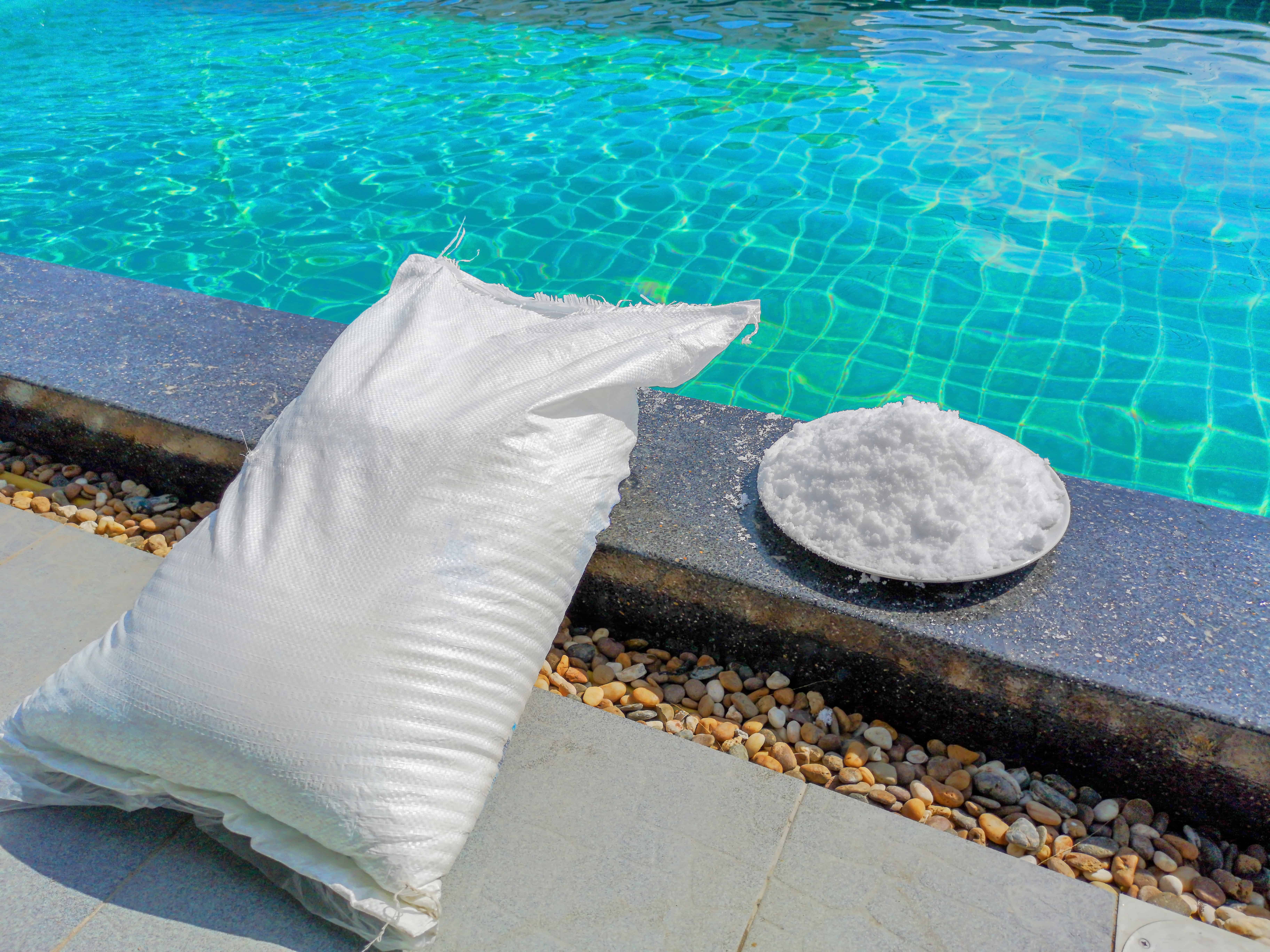The general range for salt in a saltwater pool measured in parts per million is 2,700 – 3,400 ppm. The ideal level is considered by pool equipment manufacturers like Hayward to be 3,200 ppm.
3,200 ppm is a great number to aim for because it’s at the high end of the desired salt level range. When salt levels drop over time – and salt will decrease for specific reasons – you have enough leeway that you won’t suddenly run low and get an unexpected low salt warning.
But how much salt should you add when it’s time to do so? It depends on your current salt level and the amount of water in your pool.
How Much Salt To Add To Your Pool To Reach The Ideal Level
The table below shows a number of scenarios. The rows from top to bottom show possible current salt levels and the columns from left to right show common pool volumes in gallons and Liters. Find your current situation and the chart will show you how many pounds or kg of salt to add to get the level to the Ideal Level.
For example if your current salt level is 2,400 ppm and you have a 16,000 gal (60,000 L) pool, you need to add 107 lbs (48 kg) of salt to reach the ideal range of 3,200.
Be sure not to add too much salt. It’s always easier to add more salt than to remove it since that means pumping water out and replacing it with fresh water.
| Current salt level | 12,000 gal (45,000 L) | 14,000 gal (52,500 L) | 16,000 gal (60,000 L) | 18,000 gal (67,500 L) | 20,000 gal (75,000 L) | 22,000 gal (82,500 L) | 24,000 gal (90,000 L) |
| 2,000 ppm | 120 lbs (55 kg) | 140 lbs (64 kg) | 160 lbs (73 kg) | 180 lbs (82 kg) | 200 lbs (91 kg) | 220 lbs (100 kg) | 240 lbs (109 kg) |
| 2,200 ppm | 100 lbs (45 kg) | 117 lbs (53 kg) | 133 lbs (61 kg) | 150 lbs (68 kg) | 167 lbs (76 kg) | 183 lbs (83 kg) | 200 lbs (91 kg) |
| 2,400 ppm | 80 lbs (36 kg) | 93 lbs (42 kg) | 107 lbs (48 kg) | 120 lbs (55 kg) | 133 lbs (61 kg) | 147 lbs (67 kg) | 160 lbs (73 kg) |
| 2,600 ppm | 60 lbs (27 kg) | 70 lbs (32 kg) | 80 lbs (36 kg) | 90 lbs (41 kg) | 100 lbs (45 kg) | 110 kg (50 kg) | 120 lbs (55 kg) |
| 2,800 ppm | 40 lbs (18 kg) | 47 lbs (21 kg) | 53 lbs (24 kg) | 60 lbs (27 kg) | 67 lbs (30 kg) | 73 lbs (33 kg) | 80 lbs (36 kg) |
| 3,000 ppm | 20 lbs (9 kg) | 23 lbs (11 kg) | 27 lbs (12 kg) | 30 lbs (14 kg) | 33 lbs (15 kg) | 37 lbs (17 kg) | 40 lbs (18 kg) |
| 3,200 ppm | Ideal level | Ideal level | Ideal level | Ideal level | Ideal level | Ideal level | Ideal level |

How To Add Salt To Your Saltwater Pool
Salt gets added directly to the pool by dumping a bag(s) into the water. Don’t add it to the skimmer. You should add the salt directly to the water.
The questions are:
- Should you add it to the deep end or shallow end?
- Should the pump be running?
- Should the chlorinator be running?
I’ve always just dumped salt into the deep end of the pool with the pump and chlorinator running. Having said that, your pool company or chlorinator might suggest something different.
One strategy is to add the salt around the perimeter of the pool. So you slowly pour the salt out of the bag while slowly walking around the pool. A 40 lb bag of salt will empty pretty quickly but you can at least spread it out a bit.
Then use your pool pole brush to spread the salt out a bit more and help it circulate.
With the pump and chlorinator running as normal, it will help to more quickly circulate the salt and get it throughout the water. If you use water softener salt, it may take up to 24 full hours for the salt to fully disintegrate. Using finer pool salt will dissolve much quicker.
After 24 hours, check the salt level to see where it’s at. If it’s still low, wait another day before adding any additional salt in case it hasn’t fully circulated yet.
Final thoughts
Before adding salt in large amounts, double check your current salt level. Use your chlorinator’s live salt reading and a pool water strip test if you have one just to be sure.
Adding more salt is easy, and can be done at any time. If you exceed the desired 3,400 ppm level, the only way to lower it is to either wait for it to drop over time or by draining some water and refilling with fresh water to dilute it.

